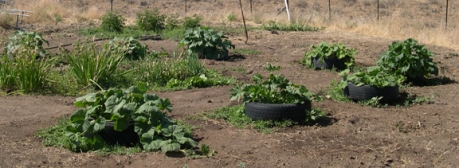By Barbara H. Peterson
This year we have the best high desert garden yet. We planted carrots, spinach, beets, swiss chard, cabbage, lettuce, onions, radishes, butternut squash, zucchini, and raspberries. Since the weather is so unpredictable, I am keeping tomato, pepper and cucumber plants indoors. We didn’t have to plant the milk thistle, as it has been trying to grow in my back yard for years, and I finally found out that eradicating this precious plant is not in our best interests!
Here are pics of the outdoor portion of the garden:
Getting to this point has taken us over three years, as we hadn’t a clue about gardening when we started, much less in the high desert, and we basically started from scratch with space for a garden area and plenty of horse manure.
Making good choices
We have learned over the years that making good choices for your particular area is vital in having and maintaining a thriving garden.
This year, we planted in mid-June because that is when we were most likely to not have an overnight frost. We also created rows with trenches on each side so that the trenches could be filled with water on each side of the row, so the plants can get maximum water. It is very dry here, and we had to water twice a day for a while until the plants started taking root and maturing. Now we are down to once per day.
We had good experiences previously with carrots, beets, cabbage, spinach, swiss chard, lettuce, onions, and zucchini, but this year the trenches next to the rows made a huge difference. We’ve got a much bigger harvest.
Another new thing that I did is take our old tires, place them in a pattern in the garden area, and fill with soil and manure. I then dug a trench around each tire and planted butternut squash and zucchini in the tires. As you can see by the following pictures, they love it!
A Volunteer Arrives with Blessings in Hand
When I first saw milk thistle growing in my back yard, I found out that the USDA has declared it a noxious weed. I knew nothing about it, and it was only this year that I found out just how beneficial it is, so I cultivated it along with the rest of the garden instead of trying to eradicate it.
This volunteer milk thistle has turned out to be a blessing, contrary to popular USDA spin that it is a noxious weed. Both Brian and I have been drinking milk thistle tea and eating the steamed seeds from our plants now for a few weeks, and we can notice a big difference in clarity, energy, and overall well-being.
This herb is wonderful and appropriate for anyone who is under stress, uses alcohol, recreational drugs, prescription medications, or lives in today’s modern times of pesticides, environmental toxins, and pollution? Virtually every person in an industrial nation.
One of the special qualities of Milk Thistle is that it cleanses and detoxifies an overburdened and stagnant liver while also being able to strengthen and tonify a weak liver; thus, delivering potent medicine to clogged, excess conditions as well as to weakened, deficient conditionals. One of the tasks of the liver is to cleanse the blood. If the liver energy is stagnant it will be unable to effectively cleanse the blood; this can result in skin problems ranging from acne to psoriasis, eczema, and dermatitis. Milk Thistle is a powerful herb for supporting the liver to purify the blood and is one of the best herbs for the skin disorders mentioned above. It is also effective for treating congestion of the kidneys, spleen, and pelvic region.
In fact, the active ingredient in the milk thistle seed is silymarin:
Silymarin is the key constituent in Milk Thistle Seed. Silymarin is a flavonoid composed of 4 isomers: silybinin, silychristin, silydianin, isosilybinin. Silymarin is only soluble in Alcohol and not water, thus making an alcohol extract the preferred medium of extraction. Much research has been done on Silymarin and at this time the only known source is the Milk Thistle Seed.
Milk thistle just happens to be the only known source for silymarin, the active ingredient responsible for helping to regenerate your liver, and clean your blood. If more people were to catch on to this, we’d be healthier, and not need so many medications.
No wonder the USDA has milk thistle classified as a noxious weed! It’s way too good for you, and our health is simply not in the forefront of Corp USA’s population control agenda.
Here is a link to a recipe for making your own milk thistle extract:
How to Make Your Own Milk Thistle Seed Extract
http://www.ehow.com/how_5626793_make-milk-thistle-seed-extract.html
This experience is teaching me that it is possible to learn how to grow good, nutritious food, even in a gardening-challenged area. The key is to know what to plant, when to plant it, how to take care of it, and when not to eradicate a “weed” that just might be extremely good for your health. It is time to let go of the USDA propaganda, and learn for ourselves what is good for us. I know that I will never be the same. Here’s to green thumbs and happy livers!
© 2010 Barbara H. Peterson
Related
Tags: agriculture, food localization, gardening, growing your own, milk thistle






You folks are sure on the right track, we might need your help in September, when Bill S510 which is a Monsanto inspired bill, that takes away from us our God given right to grow our own food!!! They want us eating their poison, it makes us sick and helps big pharma make more money, and if we die, well…that’s just reducing the population! Let’s write our Senators and fight this bill tooth and nail before Sept!! but it may be added to some other bill before then!!
fantastic article, valuable info … thank you